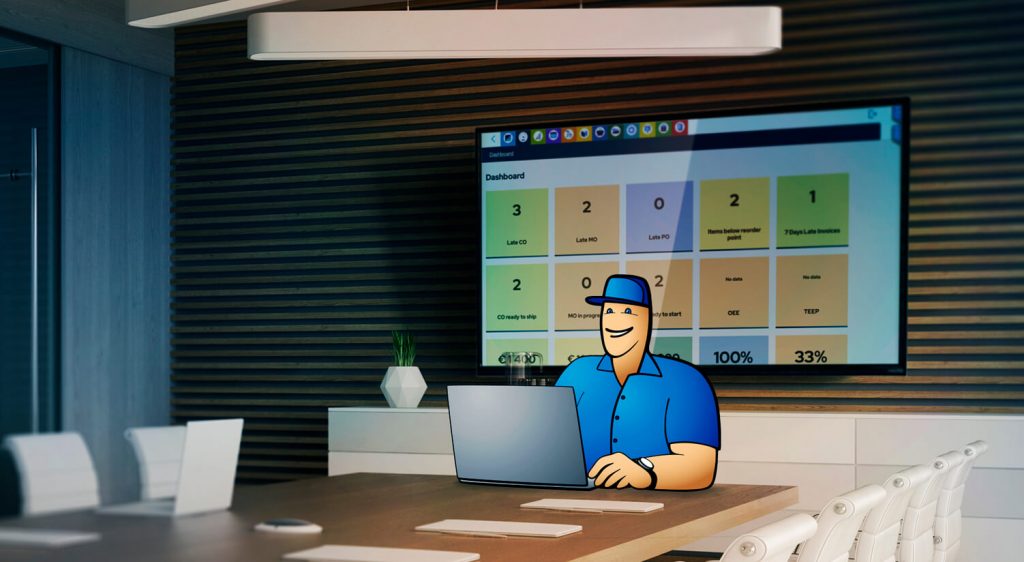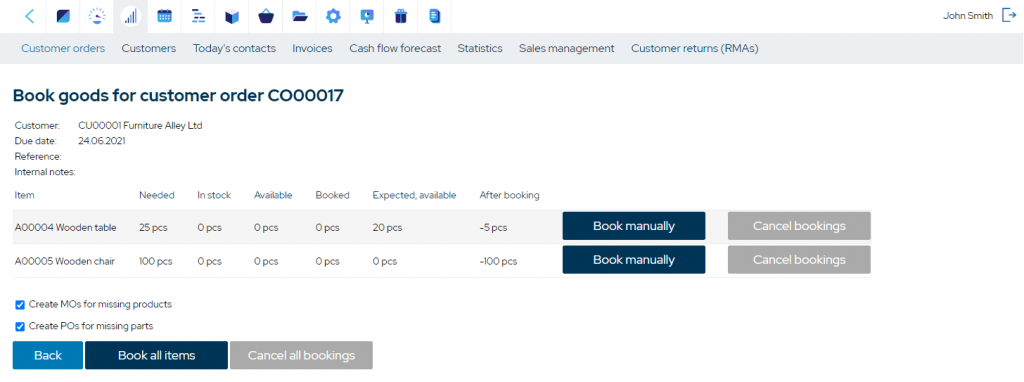Order Management With Manufacturing Software
When a manufacturing company reaches a certain point, order management becomes too complex to be done manually. This is again where digital solutions come to the aid of the manufacturer.

You can also listen to this article:
Traditional OMS Is Not Enough
In a highly competitive economy, manufacturing companies must undertake order management with precision and diligence. For many years, this was done through the use of an Order Management System (OMS). A company’s customers could build reliance and confidence in the brand itself with a robust order management system, creating value through increased customer loyalty because they receive their goods within expected delivery windows.
But traditional OMS had a shortcoming that the digital age and rise of automated software laid bare.
These programs were often standalone and independent of other software used to drive production. Additionally, OMS systems were usually considered as something to be managed and maintained by sales departments. The result was creating a siloed set of information and data that left open the possibility of human error, omission, and subjectivity.
Evolution of ERP
As the power of agile, modular, and cloud-based software came of age alongside advanced data collection, Enterprise Resource Planning systems began to evolve. Today’s ERP systems encompass traditional core functionality such as manufacturing, inventory management, and purchasing. But many have also added functionality for Human Resources, advanced procurement functionality, Business Intelligence, and Customer Relationship Management (CRM).
With the combination of these added functionalities, companies that use manufacturing ERP software can now have a seamless and integrated system that includes all the features of an Order Management System. Because the software is integrated, it makes the order management function faster, more accurate, and less likely to contain errors.
The fact that the different modules in a modern ERP or MRP system are highly integrated, allows for better inter-departmental communication. For example, a customer order (CO) can be used to automatically raise manufacturing orders for the necessary final products, as well as purchase orders (POs) for materials or components required in production.

Read also about the Top Six Manufacturing ERP Systems for Small Manufacturers.
Order Management Within Manufacturing Software
By including order management functionality within an ERP platform, companies can realize a centralized location for order management from every sales channel. This means that they can have a more holistic and accurate view of demand, supply, production, inventory, and distribution within an entire system. Data can be leveraged to optimize the factory and create greater efficiency and cost savings while improving customer confidence.
For optimized order management within an ERP system, software functionality must include critical features that allow a manufacturing company to track orders through their entire cycle from quoting through shipping. These features include:
Creating Quotes
By using cost estimation and quoting software to link quote creation with existing inventory and production schedules, sales staff can create realistic quotes with reliable delivery dates. This means fewer chances for missed shipments and a better customer experience. Many ERPs can allow the quoting agent to determine whether the finished goods will be produced from inventory or purchased stock. The links to inventory and procurement are automated through the ERP. Inventory remains accurate and not over-promised should the quotation turn to a firm order, and the purchasing automation means tighter control and efficiency of the supply chain. The result is an accurate quote that gives the sales staff the cost, price, and availability date for all items quoted.
Price Lists
Today’s ERP systems allow for the creation of price lists. Traditionally, a subjective verbal or “back of napkin” function in many companies, price lists enable production planning and inventory control to produce optimum efficiency. Most even allow tiered pricing, where different prices can be assigned based on order quantity. This leverages the power of volume production for reduced setups and changeovers and ensures that the company holds to a specific profit target for smaller, more expensive runs. The ability to have pricing within the ERP helps improve quoting, production planning, and purchasing accuracy.
Advanced Documentation
By rolling in a full suite of order management documentation and linking them to the overall ERP functionality, the traditional shuffling of paper documents is eliminated. This means faster, more accurate documentation that traces the entire history of an order. Further, history is linked to the whole operation, eliminating overestimating, underestimating, or lost order components. Key documents found in order management document creation can include:
– Quotation: Issued at customer request to provide pricing information.
– Pro-Forma Invoicing: The formal offer of goods and services at a specified price (usually with an expiry).
– Prepayment Invoicing: Many companies require partial or “down” payment for goods before beginning production.
– Order Confirmation: The acknowledgment that the order was received, accepted, and is now scheduled for production.
– Invoice: payment request issued to the customer for goods and services.
Tracking Order Progress
With a fully linked ERP, the status of orders can be tracked at any point in the production cycle. Order status can be tracked by part status, invoice status, or payment status. Manufacturing software can also allow for monitoring single items on a customer order or all of the specific customer’s order. This is in addition to the ERP system’s ability to track all production through countless filter levels to optimize the production flow.
End-to-End Visibility
The advanced functionality and interoperability of today’s ERP software mean that orders can be tracked from quotation through delivery. Most ERPs achieve this by assigning a status to the order, and many of these statuses can be automated. The production commencement or completion usually triggers automated statuses. By assigning statuses driven by the system, customers, sales, executives, and others can see the stage to know that it is on track or make decisions and notify customers if it is not. Status options generally available include:
– Quotation
– Awaiting Confirmation
– Awaiting Production
– In Production
– Ready to Ship
– Shipped and Invoiced
– Delivery
Cash Flow Analysis
Few issues are as crucial to any company as cash flow. With siloed systems and software, this can become a guessing game where mistakes can dry up working capital and create bottlenecks with suppliers and delivery to customers. Because order management is included from quote to delivery, decision-makers have the flexibility to accurately review an analysis of each order’s impact on cash flow. This can be done by a flexible custom period for both short-term and long-term management of cash flow. Because it is linked with the ERP system, decision-makers can understand the impact of firm orders and quoted orders to determine the best production strategy. This gives them the option of more concise decisions on overtime, added capacity, expedited material shipping, etc., that will result in the most desirable cash flow and the best delivery performance.
Order Booking
For many years, order booking was a manual process. Orders received from sales were entered manually after receipt or transferred by data entry from an OMS sales system. This created several problems. First, it was time-consuming, creating a lag between the point of sale and production. Second, it was prone to human error. And third, it disengaged vital data that could have been processed analytically to optimize the entire enterprise. Using order management within the ERP system, planners can automatically check current stock and book the order, triggering any purchasing for stock materials or replenishment. The system can also relieve supply via FIFO or other inventory management methodology to keep inventory accurate and keep its cost down.
Statistical Order Analysis
Order management within manufacturing ERP has the benefit of statistical order analysis through the point of shipment. This is done at the customer level, shipped goods level, and aggregate customer order levels. By understanding the analysis of these levels, companies can better plan for expansion, negotiate vendor contracts more favorable to them, tighten up production, supply, and logistics issues and undertake process or cost improvement to improve performance. Many critical KPIs are provided with this functionality, including:
– Material Cost
– Overhead Cost
– Profit
– Labor Cost
– Delay in Days
– On-Time Delivery Percentage
– Sell Price
Invoicing
With an ERP that combines order management with traditional ERP functionality, the final and most crucial step of invoicing can be rolled into the system as well. This allows real-time accuracy for the financial functions of the ERP and keeps transactions automated and error-free. Functionality may include the option of sending generated invoices directly to an email client from the software, eliminating the need to toggle between screens. And invoices can be customized with company letterhead and logo for consistency and best practices.
Today’s manufacturing ERP software systems are versatile and include functionality for more than just production and inventory management. But by tying these together and linking them across the enterprise, companies can reduce costs and identify areas for process improvement. They can also leverage real-time data for better decision-making and ensure that orders are connected to the same data that drives manufacturing to deliver the best customer experience and improve brand loyalty.
Key takeaways
- The objective of order management is to expedite order processing so that the orders are fulfilled at an accelerated pace.
- Standalone, single-department OMS systems create siloed information and pose risks such as human error, data omission, etc.
- Today’s ERP systems are so advanced that they offer order management functionality that is tied together with other vital areas of a manufacturing company, such as production planning and scheduling, purchasing, inventory, and finances.
- This integrated approach provides companies with a holistic and accurate view of demand, supply, production, inventory, and distribution within an entire system.
- A modern ERP system allows the company to track order statuses throughout the order cycle and keep all parties informed about any changes or hiccups. It also helps companies analyze their performance and improve their processes.
You may also like: Lead Time 101 – Definitions, Tips, and Tools for Manufacturers




